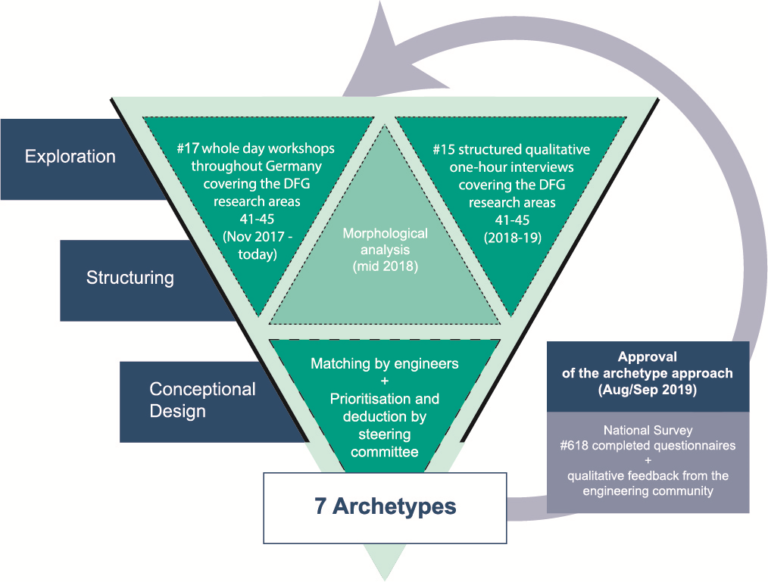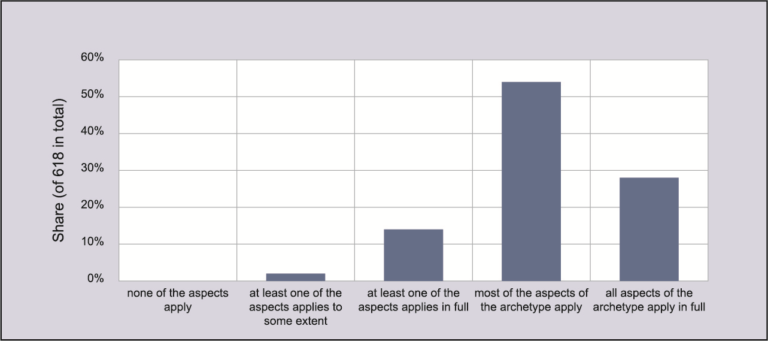the archetype concept
From its inception, NFDI4Ing opted for a methodical and user-oriented approach to meet the requirements of the engineering sciences (research areas 41-45 according to the DFG classification 2016-2019 [only available in German]). In this heterogeneous community of highly specialised research (sub-)areas, a vast number of individualised approaches and extremely focussed tools and applications have been developed. Primarily due to their often lacking modularity, these tools and approaches can rarely be reused or applied to new problems by engineering research groups with similar, yet slightly different requirements. Additionally, the tools and applications are often not sustainable and easily outdated from the point of IT progress or new scientific demands. We consider this to be highly inefficient. In NFDI4Ing, we decided to lay ground for a systematic solution of this challenge by developing a new solution design: the archetype concept.
approach & results
To identify the specific needs of the engineering science community, we used a mixed-method approach including the collection of qualitative and quantitative data. Since 2017, we conducted semi-standardised face-to-face interviews with representatives from the five DFG research areas of interest and a number of workshops with different foci, each reaching from 12 to 50 attendees.The objective of this exploratory phase was to provide a broad overview of the current state and needs regarding research data management (RDM) in the engineering sciences. Based on this data, we developed 24 key dimensions for describing engineering science as morphological box, a heuristic problem solving method e.g. used for the development of product innovations. Then, this morphological box was used in the structuring process to categorise individual researchers according to their respective characteristics and to identify our most important target groups in terms of prototypical engineering scientists or methodological archetypes. In total, we derived seven archetypes being representative for the majority of the engineering sciences and derived method oriented task areas from each of these archetypes:
- Alex: bespoke experiments with high variability of setups
- Betty: engineering research software
- Caden: provenance tracking of physical samples & data samples
- Doris: high performance measurement & computation
- Ellen: extensive and heterogeneous data requirements
- Frank: many participants & simultaneous devices
- Golo: field data & distributed systems
These archetypes define typical research methods and workflows classifying corresponding challenges for research data management. So, engineers will be reached via their identification with the methodological archetypes. You can find further information on each archetype on their respective profile pages linked below.
evaluation & further development
NFDI4Ing is and will continue to put emphasis on the identification and harmonisation of engineering research archetypes. Therefore, we are aiming to continually evaluate whether our community of interest (still) feels represented by the deduced archetypes. In a first step to this end we conducted an online survey in mid-2019. This method allowed approaching and involving a significant number of engineering scientists. The survey consisted of two parts: (1) RDM-related questions and (2) evaluation of the archetypes. We used an extensive mailing list including engineering research associations and other potential disseminators to achieve a reasonable sample size. Thus, we reached engineering research groups at all German universities and universities of applied sciences, as well as at all nonuniversity engineering research institutions (e.g. Fraunhofer institutes, Helmholtz centres, governmental research institutes, etc.). In total, 618 engineers completed the survey (each representing one research group from all fields of engineering), providing a solid basis for evaluating our approach.
Analysis of the survey data confirmed the representativeness and relevance of our seven archetypes: 95% of all research groups identify themselves with at least one archetype. The typical engineering research group combines elements of three to four archetypes and considers on average two archetypes as very relevant, showing a good division of demands by the archetypes. These findings are mostly independent of the engineering sub-discipline. These conclusions are further supported by the aforementioned interviews and workshops giving valuable qualitative feedback regarding our method-oriented and user-centred approach.
We are deeply committed to keeping up to date with the developing needs and demands in RDM in the engineering sciences. With our Community Clusters we try to establish a consistent dialogue between the consortium and the individual engineering research areas – both for sharing results and best practices, as well as to stay current on the developements and requirements of the engineering sciences. Via our seed funds programme we offer funding for innovative ideas and projects that further develop our work programme. Should the need arise, we are always open to modify our archetypes (or even add a new one).


